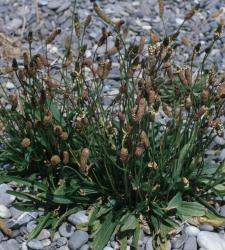- Taxon
- Gallery
Perennial herb with persistent taproot. Lvs all radical, rosulate, hairy; petiole 1–7–(20) cm long, channelled, with silky white tuft of hairs and often purplish at base. Lamina 2–20 × 0.5–4.8 cm, linear-lanceolate to elliptic-lanceolate or elliptic, 3–7-veined, glabrate or hairy, especially on the veins beneath, sometimes villous when young and sometimes remaining ± villous, entire or slightly toothed; base attenuate to the ill-defined petiole; apex acute to short-acuminate. Scape 12–70 cm long, sparsely to densely clothed in antrorse hairs, strongly ribbed. Spike very congested, to c. 6 cm long, ± oblong, occasionally infl. capitate, sometimes with short subsidiary spikes near base. Bracts 3–6 mm long, acuminate; keel green, the upper part of bract otherwise brown. Sepals (2.3)–2.7–3.5 mm long, unequal with anterior pair fused; midrib green, often hairy; upper part otherwise brown; margin usually membranous. Corolla tube = calyx; lobes c. 2 mm long, ovate, patent or reflexed, concave. Stamens glabrous, exserted. Styles exserted, occasionally to 15 mm long, densely hairy. Capsule usually 2.5–3.5 mm long, ellipsoid, (1)–2-seeded. Seeds 2–3 mm long, ellipsoid, medium to dark brown; inner surface concave, with involute margin.
[From: Webb et al. (1988) Flora of New Zealand. Volume 4.]
Flowering: Jul.–Apr.




